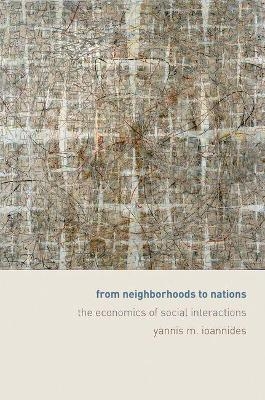
From Neighborhoods to Nations
Princeton University Press (Verlag)
978-0-691-12685-2 (ISBN)
- Lieferbar (Termin unbekannt)
- Versandkostenfrei innerhalb Deutschlands
- Auch auf Rechnung
- Verfügbarkeit in der Filiale vor Ort prüfen
- Artikel merken
Just as we learn from, influence, and are influenced by others, our social interactions drive economic growth in cities, regions, and nations--determining where households live, how children learn, and what cities and firms produce. From Neighborhoods to Nations synthesizes the recent economics of social interactions for anyone seeking to understand the contributions of this important area. Integrating theory and empirics, Yannis Ioannides explores theoretical and empirical tools that economists use to investigate social interactions, and he shows how a familiarity with these tools is essential for interpreting findings. The book makes work in the economics of social interactions accessible to other social scientists, including sociologists, political scientists, and urban planning and policy researchers. Focusing on individual and household location decisions in the presence of interactions, Ioannides shows how research on cities and neighborhoods can explain communities' composition and spatial form, as well as changes in productivity, industrial specialization, urban expansion, and national growth.
The author examines how researchers address the challenge of separating personal, social, and cultural forces from economic ones. Ioannides provides a toolkit for the next generation of inquiry, and he argues that quantifying the impact of social interactions in specific contexts is essential for grasping their scope and use in informing policy. Revealing how empirical work on social interactions enriches our understanding of cities as engines of innovation and economic growth, From Neighborhoods to Nations carries ramifications throughout the social sciences and beyond.
Yannis M. Ioannides is the Max and Herta Neubauer Professor of Economics at Tufts University.
Preface xi Chapter 1 Introduction 1 *1.1 From Urban Externalities to Urban Interactions 2 *1.2 Economies of Cities and New Economic Geography 6 *1.3 Urban Structure and Growth 8 *1.4 Urban Interactions, Politics, andUrban Design 9 *1.5 Moving Forward 9 Chapter 2 Social Interactions: Theory and Empirics 11 *2.1 Introduction 11 *2.2 A Simple Linear Model 14 *2.3 Endogenous Social Structure 22 *2.4 Nonlinear Models 30 *2.5 Why Experimental Data Can Help 38 *2.6 Endogenous Social Structure Revisited: Dynamics 44 *2.7 Econometrics of Social Interactions in Social Networks 53 *2.8 Spatial Econometrics Models as Social Interactions Models 61 *2.9 Social Learning in Urban Settings 64 *2.10 Conclusions 66 *2.11 Highlights of the Literature and Further Study 67 *2.12 Appendix: Basic Facts of Graph and Network Theory for Social Network Modeling 68 *2.13 Appendix: Survey of Micro Data Sources with Rich Contextual Information 71 Chapter 3 Location Decisions of Individuals and Social Interactions 79 *3.1 Introduction 79 *3.2 Aspatial Models of Location with Social Interactions 82 *3.3 An Exact Solution for Hedonic Prices in a Model of Sorting 88 *3.4 A Discrete Location Problem with Endogenous and Contextual Effects 95 *3.5 Endogenous Neighborhood Choice and Contextual Effects in Housing Decisions 97 *3.6 Spatial Clustering and Demographic Characteristics: Schelling's Models 115 *3.7 Hierarchical Models of Community Choice with Social Interactions 126 *3.8 Conclusion 134 *3.9 Appendices 135 Chapter 4 Location Decisions of Firms and Social Interactions 148 *4.1 Introduction 148 *4.2 Models of Location of Firms 150 *4.3 Location of Firms under Uncertainty 153 *4.4 Testing for Agglomeration 158 *4.5 Other Approaches to Studying Agglomeration Economies 169 *4.6 Empirical Evidence on Urbanization (Jacobs) Externalities: A Look from the Total Factor Productivity of Firms 180 *4.7 The Role of Inputs and Geography in Location Decisions of Firms 183 *4.8 Economic Geography Models for Firms' Location Decisions 188 *4.9 Risk Pooling by Firms in the Urban Economy 192 *4.10 Conclusion 198 Chapter 5 Social Interactions and Urban Spatial Equilibrium 200 *5.1 Introduction 200 *5.2 Urban Spatial Equilibrium with Social Interactions 206 *5.3 Location Decisions of Firms in Urban Space 212 *5.4 Monocentric versus Polycentric Models of the Urban Economy 217 *5.5 The Lucas-Rossi-Hansberg Models ofUrban Spatial Structure with Productive Externalities 219 *5.6 Neighborhood Effects and theGeometry of the Canonical Urban Model 226 *5.7 Transmission of Job-Related Information and Urban Equilibrium 234 *5.8 Choice of Job Matching and Spatial Structure 240 *5.9 Conclusions 246 Chapter 6 Social Interactions and Human Capital Spillovers 248 *6.1 Introduction 248 *6.2 Spatial Equilibrium 251 *6.3 Spatial Interactions and Spatial Economic Activity 253 *6.4 The Urban Wage Premium and Spatial Equilibrium 259 *6.5 Social Interactions and Human Capital Accumulation 268 *6.6 Social Interactions in Synthetic Neighborhoods 284 *6.7 Conclusions 286 *6.8 Guide to the Literature: Chapters 3-6 287 Chapter 7 Specialization, Intercity Trade, and Urban Structure 292 *7.1 Introduction 292 *7.2 Empirical Evidence on Urban Specialization and Diversification 294 *7.3 Simple Economics of Urban Specialization 297 *7.4 Specialization, Diversification, and Intercity Trade 306 *7.5 Equilibrium Urban Structure with Intercity Trade 318 *7.6 Richer Urban Structures 323 *7.7 The Role of Geography 326 *7.8 Labor Market Frictions in a System of Cities 330 *7.9 Modeling Lessons from the Empirics of Urban Specialization and Diversification 344 *7.10 Summary and Conclusions 346 Chapter 8 Empirics of the Urban Structure and Its Evolution 349 *8.1 Introduction 349 *8.2 Zipf's Law for Cities 350 *8.3 The Duranton Model of Endogenous City Formation 364 *8.4 The Hierarchy Principle 368 *8.5 Cities versus Metropolitan Areas versus Urban Places versus Densities versus Clusters 371 *8.6 Evolving Urban Structures with General Intradistribution Dependence 379 *8.7 Geography and Spatial Clustering 390 *8.8 Studies of Urban Structure Based on "Quasi-Natural Experiments" 393 *8.9 Global Aspects of City Size Distribution and Its Evolution 395 *8.10 Conclusion 396 Chapter 9 Intercity Trade and Long-Run Urban Growth 398 *9.1 Introduction 398 *9.2 Growth of Isolated Cities 401 *9.3 A Ventura-Type Model of Intercity Trade and Economic Growth 409 *9.4 Growth in an Economy of AutarkicCities 412 *9.5 Economic Integration, Urban Specialization, and Growth 420 *9.6 The Rossi-Hansberg-Wright Model of Urban Structure and Its Evolution 429 *9.7 Empirical Aspects of Urban Structure and Long-Run Urban Growth 434 *9.8 Sequential Urban Growth and Decay 440 *9.9 "Space: The Final Frontier?" 444 *9.10 Why Does a City Grow? 447 *9.11 Guide to the Literature for Chapters 7-9 448 Chapter 10 Urban Magic: Concluding Remarks 451 *10.1 Networks, Urban Infrastructure, and Social Interactions 452 *10.2 Graphs and the City 454 Notes 457 Bibliography 483 Index 517
| Erscheint lt. Verlag | 4.11.2012 |
|---|---|
| Zusatzinfo | 14 line illus. 7 tables. |
| Verlagsort | New Jersey |
| Sprache | englisch |
| Maße | 178 x 254 mm |
| Gewicht | 1134 g |
| Themenwelt | Sozialwissenschaften ► Soziologie |
| Wirtschaft ► Volkswirtschaftslehre ► Mikroökonomie | |
| ISBN-10 | 0-691-12685-2 / 0691126852 |
| ISBN-13 | 978-0-691-12685-2 / 9780691126852 |
| Zustand | Neuware |
| Haben Sie eine Frage zum Produkt? |
aus dem Bereich


